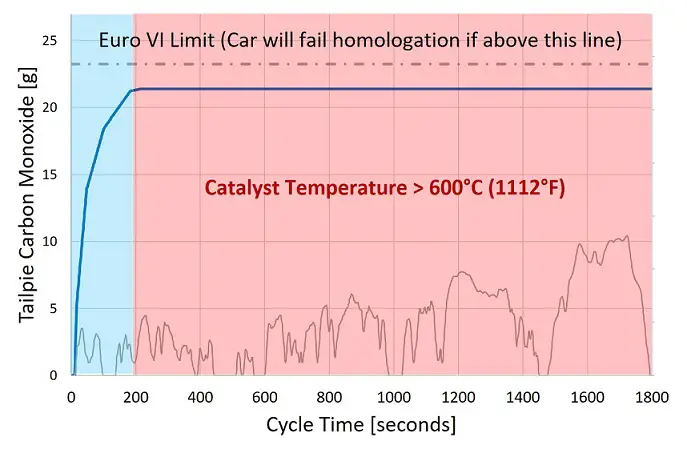Catalytic converters are often referred to in the automotive industry as ‘three way cats’ in the context of a gasoline exhaust. That’s because they convert these three harmful gases:
- NOx –> Reduced to Nitrogen, Carbon Dioxide and Water
- Carbon Monoxide –> Oxidised to Carbon Dioxide
- Hydrocarbons (unburnt fuel) –> Oxidised to Water and Carbon Dioxide

Table of Contents
Where is the Catalytic Converter Found?
The catalyst is typically as close to the engine as possible. However, earlier car models place it further away in the ‘underbody location’.
Some gasoline vehicles are adorned with 2 catalysts, the second one being found ‘underfloor’. These underfloor catalysts have become prime targets for thefts in recent years eg. Toyota Prius.
Many years ago as a student looking for my first job as an engineer, I had an interview question that went something like this-
What goes closer to the engine on a large Caterpillar truck, the turbo or the catalyst?
The interviewer then plonked a huge turbo in front of me. I knew the theory but had never actually looked under the hood so to speak!
The issue is that both turbo and catalyst are both competing for the top spot closest to the engine.
- Catalysts need heat to start working, and the quicker they warm up the quicker they are functional.
- Turbos also need heat and minimum exhaust flow restriction to be efficient.
Check out the image above and you might find the answer (under the metal heat shield). Turbos win the top spot closest to the engine 99.9% of the time. Exhaust pressure is fundamental in driving a turbo. If you put anything restrictive in front of a turbo, (like a catalyst) they lose some efficiency, which clearly is undesirable.
Why Are Catalysts Mounted so Close to the Exhaust Manifold?
They need to get hot as quickly as possible. A close couple catalyst is installed very close to the exhaust manifold. Almost all of the emissions that come out of a modern gasoline car are during the cold start phase. This is because cold catalysts are not effective. The closer to the engine, the quicker they get hot and start converting. This is what I’m talking about:

The graph shown above is an illustration of a typical WLTP cycle. It depicts a tailpipe CO trace. In order to pass emissions legislation, the catalyst needs to be hot enough to work, this is called ‘catalyst light off temperature’. Once at operating temperature, it is effective at converting basically all CO into CO2 evidenced by the straight line from 200 seconds onwards.
What Does a Catalyst Convert Nitric Oxide (NOx) into?
A catalyst reduces NOx by splitting it down into nitrogen and oxygen (some water is also created). This reaction is made possible as the engine is running close to lambda 1. What that means, is that just enough oxygen is provided to burn the fuel. Conversely, diesels run lean, where excess oxygen is provided during combustion.
For a three way catalyst to operate, the engine is calibrated to constantly switch between rich (too much fuel), and lean (too much air), see below:

When the engine is running rich (red zone) the catalyst gets to work reducing NOx. With no oxygen available and some spare hydrocarbons (extra fuel), the catalyst robs oxygen from the NOx and adds it to the hydrogen and carbon of this excess fuel, reaction summary:
NOx + HC –> N2 + CO2 + O2 + H2O
The ability for a gasoline car to emit very low NOx levels is all thanks to the catalytic converter. Diesel catalysts really struggle to lower NOx (because they’re always lean, blue portion of graph above) and that’s why even the EU emissions regulations, make an allowance for diesel, see below. The US legislators ‘Environmental Protection Agency’, (EPA) takes a less understanding approach and simply set a limit, this is probably why so few diesel passenger cars are in the US (the limit is basically half of the Euro limit):
| Diesel NOx limit (Euro VI) | 0.08 g/km |
| Gasoline NOx limit (Euro VI) | 0.06 g/km |
| General Fleet Average NOx+NMOG (US Tier 3) | 0.048 g/km |
What Does a Catalyst Convert Carbon Monoxide Into?
Carbon Monoxide (CO) is oxidized to Carbon Dioxide (CO2). The catalyst is able to do this when it is hot and has oxygen available to speed up this reaction. The oxygen becomes available every time the engine runs lean (blue portion of graph above).
What Does a Catalyst Convert Hydrocarbons Into?
Hydrocarbons (HC) are converted into water (H2O) and carbon dioxide (CO2). The catalyst is able to do this when it is hot and has oxygen available to speed up this reaction. The oxygen becomes available every time the engine runs lean (blue portion of graph above).
What Year did Catalytic Converters Appear in Cars
In the US, 1975 was the year that most new vehicles were equipped with a catalytic converter. This was to comply with the strict Californian emissions laws at the time.
Two Way Catalyst
Back in 1975 the catalysts were only 2 way catalysts. They could perform the oxidation reactions only:
- Carbon monoxide (CO) –> Carbon dioxide (CO2)
- Hydrocarbons (HC) –> Water (H2O) & Carbon Dioxide (CO2)
Three Way Catalyst
A few years later, around 1981, operation of three way catalysts became common place, adding NOx reduction to it’s arsenal.
Catalysts are now required to be fitted to vehicles to meet their emissions targets. This requirement is so severe, vehicles are now required to detect when their catalyst efficiency is below a threshold. Read all about OBD code P0420, which covers this topic in detail.
Do Catalysts Make More CO2?
Everyone knows that carbon dioxide is a green house gas. So you’d be surprised to learn that catalysts actually help make more carbon dioxide.
Carbon dioxide, although frowned upon, is not regulated. There is no hard pass / fail limit for carbon dioxide emissions. That’s because it is not considered harmful to human health- carbon monoxide is considered harmful and there is a limit in place.
In Europe consumers are encouraged to buy vehicles that produce less CO2 by tax incentives. Soon the automotive industry will completely shift away from internal combustion engines (ICE) and at that point all tailpipe emissions will effectively disappear!
What’s in a Catalyst and Why Are They So Expensive?
Catalysts are often made of ceramics, they are extruded monoliths arranged in a honeycomb for super high surface area. These ceramics are then coated with a variety of precious metals. The choices are:
- Platinum Pt ($891 / ounce)
- Palladium ($2120 / ounce)
- Rhodium ($14,000 / ounce)
Prices were correct at time of writing (October 13th 2022) It’s pretty obvious that these metals aren’t cheap and explains why catalysts are so expensive, the hardware alone can easily run to $1500+!
Automotive engineers will conduct R&D efforts to develop a winning ratio of these metals to ‘just’ meet legislative targets for the region they are selling in. No more no less!
Cost reduction is the aim of the game, a catalyst is selected to pass with the minimum amount of precious metal. As metal prices change, the composition of catalysts will also change.
Rhodium
Typically rhodium, whilst being very expensive, is actually very good at NOx conversion for gasoline exhaust gas, so will be used in markets requiring good NOx performance. The data to support these claims is proprietary and hard to come by. Of course the exact ratios are trade secrets in the aftertreatment industry, the likes of Johnson Matthey, Umicore and BASF battle it out to win big contracts with OEMs!
Platinum & Palladium
Palladium is more expensive than platinum at the moment so might not be used, as engineers favour the cheapest option that gets the job done i.e. platinum.
Conclusion
The fundamental job of an automotive catalyst is to clean up the tailpipe in line with legislative limits. The technology is very effective in a gasoline vehicle and has been incrementally improved upon for close to 50 years.
Controversial opinion alert – it is essentially an unwanted piece of expensive physical hardware! I would hazard a guess that some customers would love to save $1500+ by choosing not to have one fitted?
A huge portion of cost comes from the expensive engine calibration efforts and research and development (R&D). R&D is mainly focussed on ensuring the optimal catalyst is fitted. As well as developing an engine calibration to play to the strengths of the aftertreatment hardware. Remember the lambda graph shown above? If the engine does not continually switch between too rich (too much fuel) and too lean (excess air) then the three way catalyst will be unable to operate effectively.

